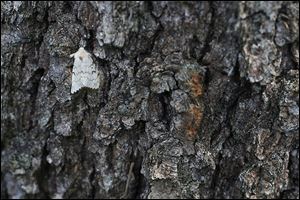
GYPSY MOTHS
State officials’ efforts look to suppress the invasive pests
7/15/2014
Amy Stone, educator with the Ohio State University Extension Office of Lucas County, stands near oak trees damaged by gypsy-moth caterpillars. Gypsy moths are a non-native, invasive pest capable of destroying trees and shrubs.
THE BLADE/KATIE RAUSCH
Buy This Image

Amy Stone, educator with the Ohio State University Extension Office of Lucas County, stands near oak trees damaged by gypsy-moth caterpillars. Gypsy moths are a non-native, invasive pest capable of destroying trees and shrubs.
It’s time to be on the lookout for gypsy moths again.
The latest generation of hairy caterpillars just moved past their leaf-munching stage in early July and began to pupate, moving the insect into its adult stage as a moth.
Residents from the Oak Openings region to the Indiana border should report any evidence they may find of an infestation.
Besides sightings of caterpillars, evidence includes trees with bare limbs and shrubs missing lots of foliage, according to Amy Stone, Ohio State University extension educator for Lucas County.
Report symptoms to the extension’s horticulture hotline from 10 a.m. to 1 p.m. Monday, Wednesday, and Friday at 419-578-6783.
“It is critical to find out where this pest is, and where populations are spreading to,” Ms. Stone said, explaining that is the kind of data the Ohio Department of Agriculture uses when determining where to spray insecticides designed to suppress gypsy moths in 2015.
The deadline to be considered for the 2015 program is Sept. 1.
Female gypsy moths are white insects that don’t fly. Males are brownish-gray and fly in erratic, zigzag patterns, following pheromones in hopes of finding females.
The Ohio Department of Agriculture’s aerial suppression effort involves putting out a product that is intended to disrupt males along their journey, leaving females to lay unfertilized eggs.
Gypsy moths are a non-native, invasive pest capable of destroying trees and shrubs or at least causing significant damage to them.
They do not confine themselves to one species: Although they prefer majestic oaks, they have been known to attack as many as 300 tree species.
In past years, the moths drew a lot of attention for the damage they caused trees and shrubs in the Sylvania area.

The gypsy moth, whose egg-laying female is pictured, is now found in 51 of Ohio’s 88 counties.
About five years ago, a significant infestation was reported in Defiance County, Ms. Stone said.
This year, they’re still in western Lucas County — mostly in the Oak Openings region, including the Springfield, Swanton, and Monclova Township areas, with some also in Providence Township — but they’ve also turned up in Fulton, Henry, and Williams counties, as well as other parts of Ohio, she said.
“There’s always been these little hot spots. It’s kind of their cycle,” Ms. Stone said.
Once infested, previously healthy trees can live another two or three years, she said.
“Populations of the gypsy moth usually begin small and continue to grow in numbers during the second and sometimes third season or year,” Ms. Stone said.
Trees stressed by other factors before gypsy moths arrive can die within a year, she said.
For more information, go to this Ohio Department of Agriculture Web site, which includes a five-minute YouTube video that provides a general overview of the pest and how to identify it: agri.ohio.gov/divs/plant/gypsy/gypsy-index.aspx.
In that video, David Adkins, the state agriculture department’s program manager for gypsy moths, provides a little history about the pest: He said gypsy moths were deliberately imported from France in the 1860s. An entomologist from that European country, who had emigrated to the United States, hoped to raise the moths in his Massachusetts laboratory to see if he could develop a better a silkworm for a business he created.
Mr. Adkins described the plan as “one of those proverbial experiments that went wrong” after a storm ripped open netting, setting the gypsy moths free.
Gypsy moths are now in 51 of Ohio’s 88 counties, the state agriculture department said.
Contact Tom Henry at: thenry@theblade.com or 419-724-6079.